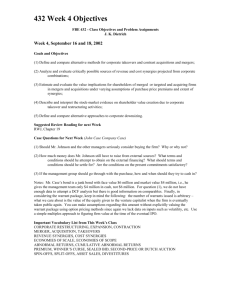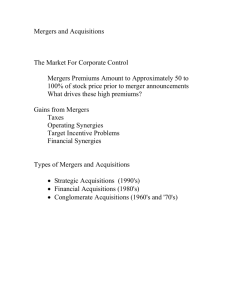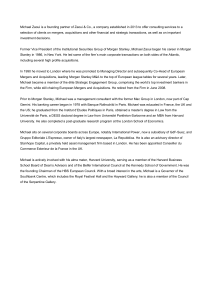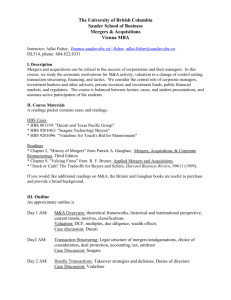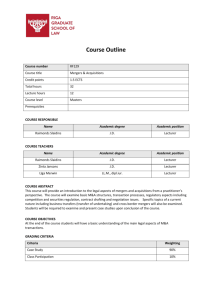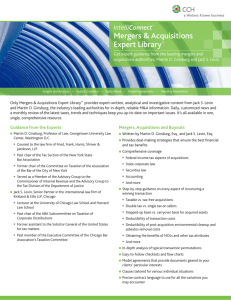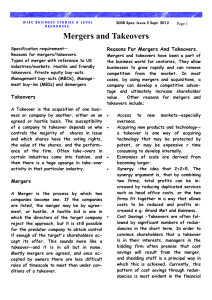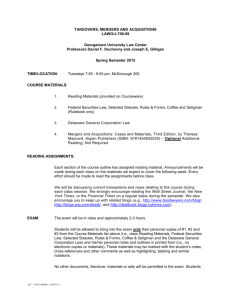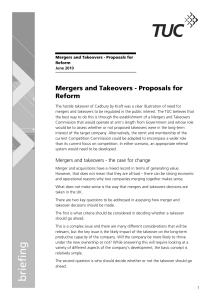Course Syllabus: Mergers & Acquisitions
advertisement
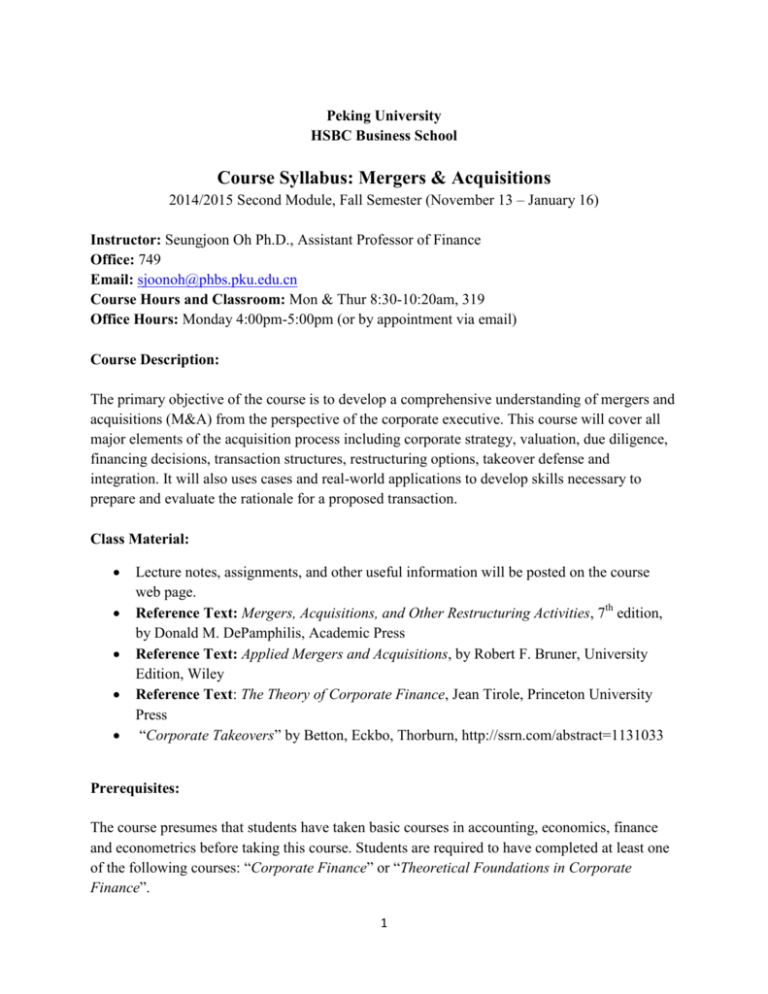
Peking University HSBC Business School Course Syllabus: Mergers & Acquisitions 2014/2015 Second Module, Fall Semester (November 13 – January 16) Instructor: Seungjoon Oh Ph.D., Assistant Professor of Finance Office: 749 Email: sjoonoh@phbs.pku.edu.cn Course Hours and Classroom: Mon & Thur 8:30-10:20am, 319 Office Hours: Monday 4:00pm-5:00pm (or by appointment via email) Course Description: The primary objective of the course is to develop a comprehensive understanding of mergers and acquisitions (M&A) from the perspective of the corporate executive. This course will cover all major elements of the acquisition process including corporate strategy, valuation, due diligence, financing decisions, transaction structures, restructuring options, takeover defense and integration. It will also uses cases and real-world applications to develop skills necessary to prepare and evaluate the rationale for a proposed transaction. Class Material: Lecture notes, assignments, and other useful information will be posted on the course web page. Reference Text: Mergers, Acquisitions, and Other Restructuring Activities, 7th edition, by Donald M. DePamphilis, Academic Press Reference Text: Applied Mergers and Acquisitions, by Robert F. Bruner, University Edition, Wiley Reference Text: The Theory of Corporate Finance, Jean Tirole, Princeton University Press “Corporate Takeovers” by Betton, Eckbo, Thorburn, http://ssrn.com/abstract=1131033 Prerequisites: The course presumes that students have taken basic courses in accounting, economics, finance and econometrics before taking this course. Students are required to have completed at least one of the following courses: “Corporate Finance” or “Theoretical Foundations in Corporate Finance”. 1 Grading: Student grades will be based on the following formula Mid-term Exam (12/11) : 100 Team Project: 100 Case study discussion questions: 30 Class participation: 20 Honor Code and Academic Conduct: As a student you are responsible for upholding academic integrity standards for this course. It is very important for you to be aware of the consequences of cheating, fabrication, facilitation, and plagiarism. For more information on the Code of Academic Integrity or the Student Honor Council, please visit: http://dean.pku.edu.cn/2011xssc/kswgclff_jyb.htm Team Project: Students will be asked to form teams of 4-5 individuals prior to the start of the second session of the class to prepare a class presentation on a pre-specified topic. Presentations will be start at week 6 and last until the end of the module. Your team project includes a final report which should be turned in electronically on or before the last day of week 9. Each team should choose one of the following topics: Topic1: Study of Challenges in Cross-Border Acquisition The objective of this study is to study recent cross-border acquisitions in which acquirers and targets have experienced challenges from country/culture-specific heterogeneity (i.e., cultural, legal or currency differences). Your group is to choose a cross-border acquisition announcement for the last ten years. Your group will prepare a paper on the acquisition selected and present your findings to the class. An outline of the topics your paper should cover will be provided. Topic 2: Study of Distressed Target Acquisitions The objective of this project is to investigate a M&A transaction that includes financially or economically distressed target. Firms that face a severe liquidity constraint may be forced to sell some or all of their assets to avoid bankruptcy. Thus, distressed acquisitions play an important role as a restructuring mechanism. Your group will prepare a paper on the acquisition selected and present your findings to the class. An outline of the topics your paper should cover will be provided. 2 Topic3: Study of Causes and Effects of Mega-Mergers Mega-mergers, the joining of two large corporations, typically involve billions of dollars in value. The megamerger creates one corporation that may maintain control over a large percentage of market shares within their industries. The objective of this study is to investigate the causes and effects of the mega-mergers on their industries. Your group will prepare a paper on the acquisition selected and present your findings to the class. An outline of the topics your paper should cover will be provided. Available Data Resources: Chinese company balance sheet data: o CSMAR® China Stock Market Financial Statements Database o http://us.gtarsc.com/p/sq/ Both the Username and Password are szpku Stock price: o CSMAR® China Stock Market Trading Database o http://us.gtarsc.com/p/sq/ Both the Username and Password are szpku M&A database o CSMAR® China Listed Firm’s Merger & Acquisition, Asset Restructuring Research Database o http://us.gtarsc.com/p/sq/ Both the Username and Password are szpku Public listed firms o CSMAR® China Listed Private Enterprise Database o http://us.gtarsc.com/p/sq/ Both the Username and Password are szpku o CSMAR® China Listed Firm Shareholder Research Database o http://us.gtarsc.com/p/sq/ Both the Username and Password are szpku Compustat Database o US firm annual/quarterly accounting data CRSP o US firm Stock price information 3 Course Outline and Schedule: Week 1-2 Topic Introduction: M&A Activity Merger waves Drivers of M&A activity Takeover contests Merger negotiation v. Public tender offer Method of Payment and Financing M&A Theory of Takeovers (Jean Tirole Chapter 11) Reading List 2-3 Betton, Eckbo, Thorburn (2008), Corporate Takeovers: Chapter 2 Betton, Eckbo, Thorburn (2008), Corporate Takeovers: Chapter 3.2 Schlingemann (2004), Financing decisions and bidder gains, Journal of Corporate Finance Case Study: TBD Does M&A create value? Tender offers and the free-rider problem Measurement of performance Drivers of profitability Synergy creation Reading List 3-5 Betton, Eckbo, Thorburn (2008), Corporate Takeovers: Chapter 3 and 4 Grossman and Hart (1990), Takeover bids, the free-rider problem, and the theory of the corporation, The Bell Journal of Economics (1980): 42-64. Bradley, Michael, Anand Desai, and E. Han Kim. (1988), Synergistic gains from corporate acquisitions and their division between the stockholders of target and acquiring firms, Journal of financial Economics Case Study: TBD M&A Valuation Due diligence Valuing firms and synergies 4 Financial accounting for M&A Reading List 5-6 Case Study: TBD Hostile Takeover and Anti-Takeover Defense Tactics of takeover attack Tactics of takeover defense Reading List 6-7 Hirshleifer, David, and Sheridan Titman, 1990, Share tendering strategies and the success of hostile takeover bids, Journal of Political Economy Cain et al. (2014), Do Takeover Laws Matter? Evidence from 45 Years of Hostile Takeovers, Working Paper Case Study: TBD Cross-Border M&A Cross-Border M&A activity Drivers and returns from cross-border M&A Valuation of cross-border firm Team Project Presentation: Topic 1 Reading List 7-8 Ahern (2014), Lost in Translation? The Effect of Cultural Values on Mergers Around the World, Journal of Financial Economics Lin et al. (2014), Currency appreciation shocks and shareholder wealth creation in cross-border mergers and acquisitions, Working Paper Mergers, Acquisitions, and Other Restructuring Activities Chapter 18 M&A and Corporate Restructuring Valuing distressed businesses Bankruptcy auctions and fire-sales Divestitures, spin-offs, and equity carve-outs Distressed debt investments Team Project Presentation: Topic 2 Reading List 5 8-9 Mergers, Acquisitions, and Other Restructuring Activities Chapter 16, 17 Betton, Eckbo, Thorburn (2008), Corporate Takeovers: Chapter 3.2 Takeovers, competition and antitrust Efficiency vs. market power: predictions Effects of merger on rival firms Effects of merger on suppliers and customers Some implications for antitrust policy Team Project Presentation: Topic 3 Reading List Shahrur, Husayn (2005), Industry structure and horizontal takeovers: Analysis of wealth effects on rivals, suppliers, and corporate customers, Journal of Financial Economics Eckbo, B. Espen (1983), Horizontal mergers, collusion, and stockholder wealth, Journal of Financial Economics 6
